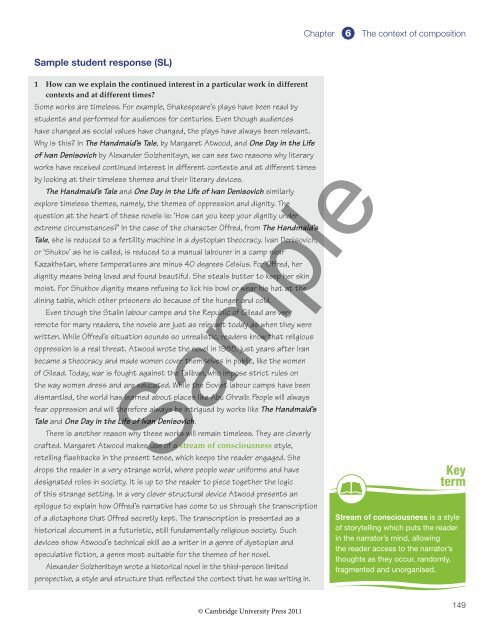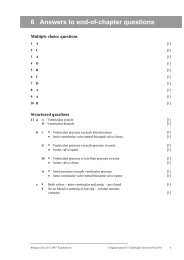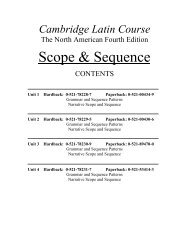Brad Philpot - Cambridge University Press
Brad Philpot - Cambridge University Press
Brad Philpot - Cambridge University Press
You also want an ePaper? Increase the reach of your titles
YUMPU automatically turns print PDFs into web optimized ePapers that Google loves.
Sample student response (SL)<br />
1 How can we explain the continued interest in a particular work in different<br />
contexts and at different times?<br />
Some works are timeless. For example, Shakespeare’s plays have been read by<br />
students and performed for audiences for centuries. Even though audiences<br />
have changed as social values have changed, the plays have always been relevant.<br />
Why is this? In The Handmaid’s Tale, by Margaret Atwood, and One Day in the Life<br />
of Ivan Denisovich by Alexander Solzhenitsyn, we can see two reasons why literary<br />
works have received continued interest in different contexts and at different times<br />
by looking at their timeless themes and their literary devices.<br />
The Handmaid’s Tale and One Day in the Life of Ivan Denisovich similarly<br />
explore timeless themes, namely, the themes of oppression and dignity. The<br />
question at the heart of these novels is: ‘How can you keep your dignity under<br />
extreme circumstances?’ In the case of the character Offred, from The Handmaid’s<br />
Tale, she is reduced to a fertility machine in a dystopian theocracy. Ivan Denisovich,<br />
or ‘Shukov’ as he is called, is reduced to a manual labourer in a camp near<br />
Kazakhstan, where temperatures are minus 40 degrees Celsius. For Offred, her<br />
dignity means being loved and found beautiful. She steals butter to keep her skin<br />
moist. For Shukhov dignity means refusing to lick his bowl or wear his hat at the<br />
dining table, which other prisoners do because of the hunger and cold.<br />
Even though the Stalin labour camps and the Republic of Gilead are very<br />
remote for many readers, the novels are just as relevant today as when they were<br />
written. While Offred’s situation sounds so unrealistic, readers know that religious<br />
oppression is a real threat. Atwood wrote the novel in 1985, just years after Iran<br />
became a theocracy and made women cover themselves in public, like the women<br />
of Gilead. Today, war is fought against the Taliban, who impose strict rules on<br />
the way women dress and are educated. While the Soviet labour camps have been<br />
dismantled, the world has learned about places like Abu Ghraib. People will always<br />
fear oppression and will therefore always be intrigued by works like The Handmaid’s<br />
Tale and One Day in the Life of Ivan Denisovich.<br />
There is another reason why these works will remain timeless. They are cleverly<br />
crafted. Margaret Atwood makes use of a stream of consciousness style,<br />
retelling flashbacks in the present tense, which keeps the reader engaged. She<br />
drops the reader in a very strange world, where people wear uniforms and have<br />
designated roles in society. It is up to the reader to piece together the logic<br />
of this strange setting. In a very clever structural device Atwood presents an<br />
epilogue to explain how Offred’s narrative has come to us through the transcription<br />
of a dictaphone that Offred secretly kept. The transcription is presented as a<br />
historical document in a futuristic, still fundamentally religious society. Such<br />
devices show Atwood’s technical skill as a writer in a genre of dystopian and<br />
speculative fiction, a genre most suitable for the themes of her novel.<br />
Alexander Solzhenitsyn wrote a historical novel in the third-person limited<br />
perspective, a style and structure that reflected the context that he was writing in.<br />
Chapter 6 The context of composition<br />
Sample<br />
© <strong>Cambridge</strong> <strong>University</strong> <strong>Press</strong> 2011<br />
Key<br />
term<br />
Stream of consciousness is a style<br />
of storytelling which puts the reader<br />
in the narrator’s mind, allowing<br />
the reader access to the narrator’s<br />
thoughts as they occur, randomly,<br />
fragmented and unorganised.<br />
149








